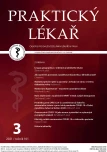Lingua geographica in the general practitioner’s surgery
Authors:
Anna Ščerbová 1; J. Šrubař 1; J. Stránský 1; J. Štembírek 1,2,3
Authors‘ workplace:
Klinika ústní, čelistní a obličejové chirurgie, Fakultní nemocnice Ostrava, Přednosta: MUDr. Jiří Stránský, Ph. D., MBA
1; Ústav živočišné fyziologie a genetiky Akademie věd ČR, Brno, Laboratoř molekulární morfogeneze, Vedoucí: doc. RNDr. Marcela Buchtová, Ph. D.
2; Ostravská univerzita v Ostravě, Lékařská fakulta, Katedra kraniofaciálních oborů, Vedoucí: prof. MUDr. Pavel Komínek, Ph. D., MBA
3
Published in:
Prakt. Lék. 2021; 101(3): 131-134
Category:
Reviews
Overview
The tongue is one of the most sensitive organs in the oral cavity. It participates in many of its functions, such as swallowing, chewing, speaking and breathing. As it is well accessible and easy to examine, it facilitates the easy recognition of multiple morphological units. One of these is the geographic tongue (also known as lingua geographica, erythema migrans, benign migratory glossitis), a benign recurrent lesion of unknown aetiology with a characteristic clinical picture. It manifests as multifocal round irregular lesions that are red in the middle with white slightly raised edges. The patient may be free of any complaints but may also complain of burning of the tongue or other discomfort. Although the lesion is benign and requires no treatment, the patient himself/herself or the general practitioner might suspect the presence of carcinoma. This paper presents the basic information and the current perspective of this morphological unit.
Keywords:
lingua geographica – mucosal disorders – oral cavity – orofacial oncology
Sources
1. Bajaj P, Kapoor C, Garg D, et al. Geographic tongue in a 6 year old child: A case report with review of literature. Dent J Adv Stud 2013; 1(2): 112–117.
2. Goregen M, Melikoglu M, Miloglu O, Erdem T. Predisposition of allergy in patients with benign migratory glositis. Oral Surg Oral Med Oral Pathol Oral Radiol Endod 2010; 110(4): 470–474.
3. Greenberg MS, Glick M, Ship JA (Eds). Burket’s oral medicine (11th Ed.). Hamilton, Ont: BC Decker 2008.
4. Hamissi JH, Esfehani M, Hamissi Z. Treatment of geographic tongue superimpsing fissured tongue: A literature review with case report. Sch J Dent Sci 2015; 2(7): 409–413.
5. Mangione S. Physical diagnosis secrets: with students consult online access (2nd Ed.). Philadelphia: Elsevier 2012; 604–605.
6. Neville BW, Allen CM, Damm ID, Chi AC. Oral and maxillofacial pathology (2nd Ed). Philadelphia: Saunders 2002; 677–679.
7. Patil S, Kaswan S, Rahman F, Doni B. Prevalence of tongue lesions in the Indian population. J Clin Exp Dent 2013; 5(3): 28–32.
8. Reamy BV, Derby R, Bunt CW. Common tongue conditions in primary care. Am Fam Physician 2010; 81(5): 627–634.
9. Shah N, Kariya P, Dave B, Thomas P. Geographic tongue: A case report with review of literature. Adv Hum Biol 2016; 6(3): 142–144.
10. Slezák R, a kol. Atlas chorob ústní sliznice. Přerov: Quintessenz 2004; 206.
11. Stoopler ET, France K, Ojeda D, Sollecito TP. Benign migratory glossitis. J Emerg Med 2008; 54(1): 9–10.
12. van der Waal I. Oral leukoplakia, the ongoing discussion on definition and terminology. Med Oral Patol Oral Cir Bucal 2015; 20(6): 685–692.
13. Yarom N, Cantony U, Gorsky M. Prevalence of fissured tongue, geographic tongue and median rhomboid glossitis among Israeli adults of different ethnic origins. Dermatology 2004; 209(2): 88–94.
Labels
General practitioner for children and adolescents General practitioner for adultsArticle was published in
General Practitioner

2021 Issue 3
Most read in this issue
- How to (correctly) process and publish case report from clinical practice?
- Our experience with the use of NPWT methods and their availability
- Lingua geographica in the general practitioner’s surgery
- Clinical course of COVID-19 in a high-risk patient
